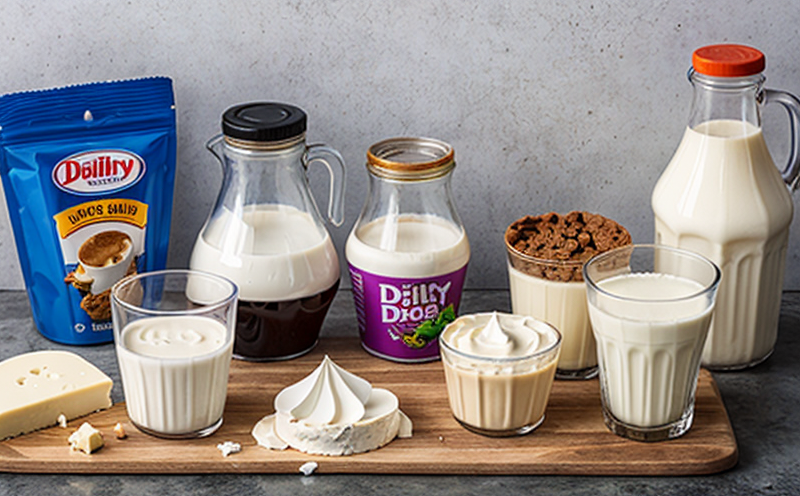ISO 707 Dairy Sampling Methods for Laboratory Testing
The International Organization for Standardization (ISO) has established ISO 707:1983, which provides guidelines for the sampling of dairy products. This standard ensures that samples are collected accurately and uniformly across various dairy product types to ensure consistency in laboratory testing.
Accurate sample collection is critical because it directly impacts the reliability and accuracy of subsequent analyses and tests performed on dairy products. Whether you're a quality manager overseeing production processes, a compliance officer ensuring regulatory adherence, or an R&D engineer developing new formulations, having a robust sampling method is essential for your operations.
The ISO 707 standard applies to various types of milk, cream, and other dairy items that are intended for human consumption. It specifies the procedures for taking representative samples from bulk containers such as tanks or silos, as well as from individual packages like bottles or cartons. The goal is to ensure that each sample accurately reflects the characteristics of the entire batch it represents.
Proper sampling minimizes bias and ensures that tests conducted are indicative of the true quality of the product. This is particularly important when dealing with perishable goods like dairy products, where even small variations can lead to significant differences in outcomes. By adhering to ISO 707 standards, laboratories can provide reliable data that helps maintain high standards of food safety and quality.
The process described by ISO 707 involves several key steps: first, selecting the appropriate sampling equipment based on the type and size of the container being sampled. Then, determining the number of samples needed according to the volume and composition of the product. After collection, samples must be handled carefully to avoid contamination or degradation.
For bulk dairy products stored in large tanks, a multi-point sampler is often used to obtain multiple discrete samples from different locations within the tank. This ensures that every part of the batch has an equal chance of being represented in the final sample set. Similarly, for smaller containers like bottles or cartons, a simple dipper or scoop may suffice.
| Standard | Description |
|---|---|
| ISO 707:1983 | Dairy Sampling Methods for Laboratory Testing |
| ASTM E2564-19 | Sampling of Bulk Dairy Products in Silos |
The selection of sampling points is crucial and should be determined based on factors such as homogeneity, flow pattern, and potential sources of contamination. Once collected, samples are typically pooled into a single container for further analysis.
By following these standardized procedures, laboratories can ensure that their results are valid and consistent with industry expectations. This not only enhances confidence in the laboratory’s findings but also supports regulatory compliance efforts by providing data that meets international standards.
Applied Standards
| Standard | Description |
|---|---|
| ISO 707:1983 | Dairy Sampling Methods for Laboratory Testing |
| ASTM E2564-19 | Sampling of Bulk Dairy Products in Silos |
Why Choose This Test
Selecting the correct sampling method is fundamental to achieving accurate and reproducible results. ISO 707 ensures that samples are representative of the entire batch, thereby reducing variability in test outcomes.
This standard is particularly beneficial for dairy producers and processors who need to demonstrate compliance with international standards. By adhering to these guidelines, laboratories can provide consistent data that supports regulatory requirements and enhances trust among consumers and stakeholders.
The benefits of using ISO 707 go beyond mere compliance; it also helps in identifying potential issues early on during production or storage phases. Early detection allows for corrective actions to be taken promptly, preventing costly recalls or product rejections later down the line.
Moreover, laboratories that follow these procedures are better equipped to handle disputes related to quality claims since they have reliable evidence supporting their findings. This can significantly reduce legal risks associated with non-compliance or discrepancies between expected and actual results.
Quality and Reliability Assurance
The quality of dairy products is paramount in maintaining consumer confidence and ensuring safety standards are met. ISO 707 plays a vital role in this regard by providing clear instructions on how to collect samples accurately.
Accurate sampling ensures that the tests conducted later will yield reliable results, which ultimately contribute to producing high-quality dairy products. This consistency is crucial not only for maintaining brand reputation but also for ensuring public health and safety.
Regular audits and training programs focusing on proper sample collection techniques help reinforce adherence to ISO 707 standards within the organization. These continuous improvement practices ensure that every step of the sampling process adheres strictly to established protocols, further enhancing reliability.
Laboratories specializing in dairy testing should invest in state-of-the-art equipment and trained personnel capable of executing these methods correctly. Investing time and resources into ensuring compliance with ISO 707 can lead to long-term cost savings by avoiding unnecessary retesting or corrective actions after initial analyses have been completed.





